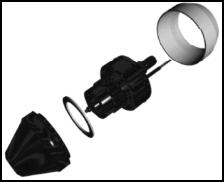



Preventing Salmonella Colonization of Chickens
By Scott M. Russell, Ph.D., Associate Professor Department of Poultry Science, The University of Georgia - Salmonella spp. may be found in the nest box of breeder chickens, cold egg-storage rooms at the farm, on the hatchery truck, or in the hatchery environment.
Introduction
These bacteria may then be spread to fertilized hatching eggs on the shell or, in some cases, may penetrate the shell and reside just beneath the surface of the eggshell.
Research has demonstrated that contamination of raw poultry products with Salmonella spp. may be attributable to cross-contamination in the hatchery from Salmonella infected eggs or surfaces to uninfected baby chicks during the hatching process. Cox et al. (6 and 7) reported that broiler and breeder hatcheries were highly contaminated with Salmonella spp. Within the broiler hatchery, 71 percent of eggshell fragments, 80 percent of chick conveyor belts swabs, and 74 percent of pad samples placed under newly hatched chicks contained Salmonella spp. (6).
 Figure 1. Electrostatic Spray Nozzle. |
Cason et al. (4) reported that, although fertile hatching eggs were contaminated with high levels of Salmonella typhimurium, they were still able to hatch. The authors stated that paratyphoid salmonellae do not cause adverse health affects to the developing and hatching chick. During the hatching process, Salmonella spp. is readily spread throughout the hatching cabinet due to rapid air movement by circulation fans.
When eggs were inoculated with a marker strain of Salmonella during hatching, greater than 80 percent of the chicks in the trays above and below the inoculated eggs were contaminated (4). In an earlier study, Cason et al. (3) demonstrated that salmonellae on the exterior of eggs or in eggshell membranes could be transmitted to baby chicks during pipping.
Salmonella may persist in hatchery environments for long periods of time. When chick fluff contaminated with Salmonella was held for 4 years at room temperature, up to 1,000,000 Salmonella cells per gram could be recovered from these samples (12).
Researchers have demonstrated a link between cross-contamination in the hatchery and contaminated carcasses during processing. Goren et al. (8) isolated salmonellae from three different commercial hatcheries in Europe and reported that the same serotypes found in the hatcheries could be found on processed broiler chicken carcass skin. Proper disinfection of the hatchery environment and fertile hatching eggs, therefore, is essential for reducing Salmonella on ready-to-cook carcasses.
Numerous studies have been conducted to evaluate sanitizing agents for disinfecting eggshell surfaces and membranes. Bailey et al. (1) reported that 2.5 percent H2O2, administered using 100 or 500 mL/h, reduced Salmonella typhimurium positive eggshells by 55 per-cent and the number of positive chicks by 53 percent. H2O2 reduced total aerobic bacterial counts(APC) in air in hatching egg incubators from 3.6 colony forming units (CFU)/L for water fogging to 0.35 CFU/L when the incubator was fogged with 3 percent H2O2 (13). Sheldon and Brake (14) demonstrated that 5 percent H2O2 reduced APC on hatching eggs from 3.98 cfu/egg for water sprayed eggs to 0.99 cfu/egg for treated eggs.
Bailey et al. (1) reported that ozone at 0.2 to 0.4 ppm reduced Salmonella typhimurium positive eggshells by 10 percent and the number of positive chicks by 26.7 percent. In another study, ozone at 3.03 percent by weight was able to reduce APC on broiler hatching eggs by 2.57 log10 cfu (15). Brake and Sheldon (2) observed that a quaternary ammonium sanitizer at 3.0 percent reduced APC on broiler hatching eggs by 99.9 percent within 30 minutes of application. The methods used to apply sanitizers in these studies varied from gaseous exposure to fogging and dipping. Method of application may have a dramatic impact on efficacy of the sanitizers used.
Law (10) developed an electrostatic spray-charging system using air atomization which achieved a 7 fold increase in spray deposition over conventional application methods (See Figure 1).

Further Information
To read the full article, click here (PDF)
December 2006








